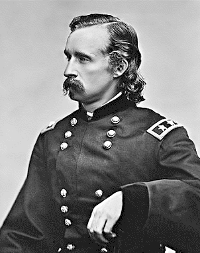On This Date In History
Custer's Plan For June 25, 1876 - Part Two
July 28, 2023
In a previous article, the topic of Custer's plan for June 25, 1876 was discussed. The article demonstrated that for a period of time before the Battle of the Little Bighorn began, it was not Custer's plan to take the regiment into the valley of the Little Bighorn that day. Interestingly, even more information has been found to substantiate this claim. One of the people to provide such information is First Lieutenant George D. Wallace.
In the days leading up to the Battle of the Little Bighorn, the 7th Cavalry was following a large Native American trail. At the time, Wallace was an officer in the regiment and was traveling with it.
As an officer, Wallace would have taken part in the management of the regiment in the days leading up to the Battle of the Little Bighorn and would have been provided with information to help him in that role. Some of the most important and pertinent information he would have received at the time would have been information regarding a plan for the regiment. He may have even helped in the planning process as this is something that officers typically do. In fact, on the night of June 22, 1876, Custer said during an officers' meeting that "I will be glad to listen to suggestions from any officer of the command, if made in the proper manner" (Merrington, 310). These words of Custer indicate that he would even listen to planning suggestions from his officers if they were made in the proper manner. This puts Wallace in an extremely rare position to not only know about Custer's plan for June 25, 1876, but to be able to influence it.
Following the Battle of the Little Bighorn, Wallace wrote about Custer's plan for June 25, 1876. He wrote that Custer's plan for that day was to "find out the locality" of the Native Americans in the valley of the Little Bighorn (Wallace). This is further evidence that at a certain point leading up to the Battle of the Little Bighorn, Custer was not planning on taking the 7th Cavalry into the valley of the Little Bighorn that day.
Another officer who wrote about Custer's plan for June 25, 1876, is Lieutenant Winfield Scott Edgerly. Edgerly was also with the 7th Cavalry in the days leading up to the Battle of the Little Bighorn.
In a letter written shortly after the Battle of the Little Bighorn, Edgerly explained that Custer's plan for June 25, 1876, was for the regiment to be "hiding in the hills" that day (Bailly). This goes along with Wallace's statement regarding Custer's plan for June 25, 1876. They both agree that at a certain point leading up to the Battle of the Little Bighorn, Custer was not planning on taking the regiment into the valley of the Little Bighorn that day.
Interestingly, this information provided by Edgerly is actually a second instance in which he provided this kind of information (the first is included in the first article in this series).
The matter of Custer's plan for the day the Battle of the Little Bighorn began is one of the most important parts of the battle. A proper understanding of it can have a significant impact on understanding the battle and the man.
Over the course of two articles, information has been provided to show that at a certain point leading up to the Battle of the Little Bighorn, it was not Custer's plan to take the 7th Cavalry into the valley of the Little Bighorn on June 25, 1876. Altogether, the information provided consists of nine statements. These statements were made by five people who were in positions to know quite well what Custer's plan was for that day. Thus, it becomes clear that at a certain point leading up to the Battle of the Little Bighorn, it was not Custer's plan to take the regiment into the valley of the Little Bighorn that day.
About the Author
Tim Kloos is an online advertising professional. He helps clients with their websites, online presence, and online advertising. If you need help with any of these, feel free to contact him via the contact page.
His tech website is clevelandwebdesignplus.com.
He has also written a children's book set in the Old West.
